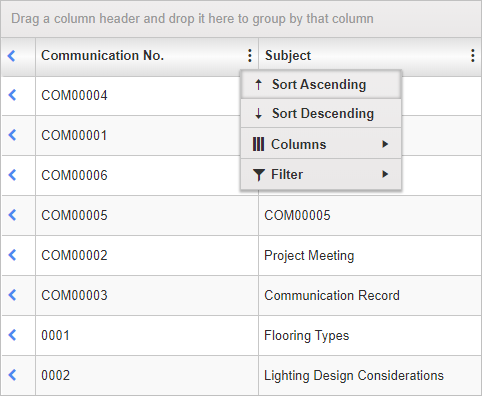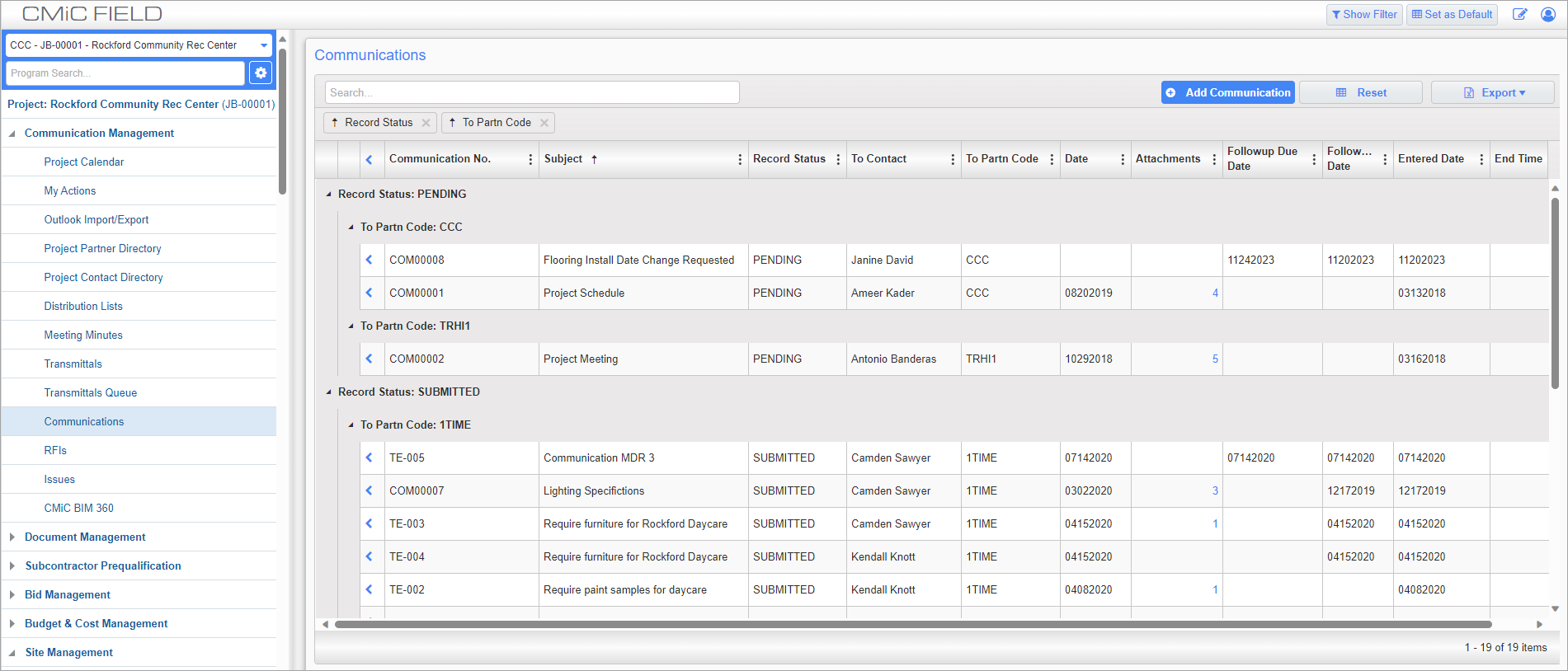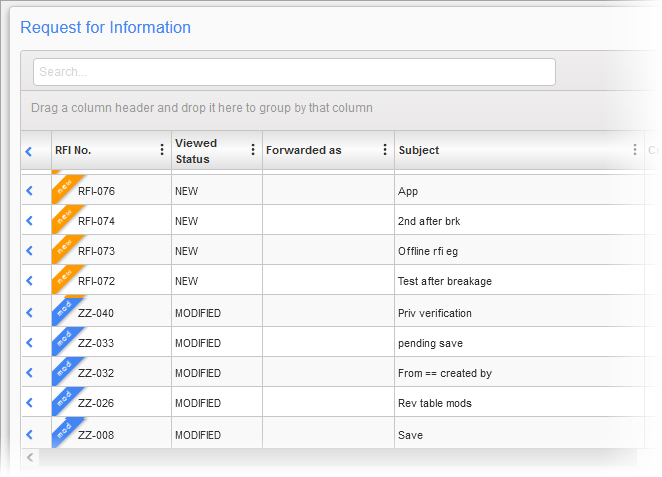
An example of a Log screen; standard Treeview path: CMiC Field > Communication Management > Communications
Logs are lists of records of specific CMiC Field objects. These are often the first screen shown when navigating to a new part of the Treeview. The object records that are shown in a log screen change from person to person as a user can only see those logs on which they were sent or copied or that they created themselves.
NOTE: User Defined Fields (UDFs) cannot be added to a JSP log. To add a UDF, please use the Classifiers screen (standard Treeview path: System > User Extensions> Classifiers). For more information, please refer to
[Add…] – Button
Each log screen comes with a button for adding records. For example, as in the screenshot above, press the [Add Communication] button to enter, save, and submit communication object records.
[Reset] – Button
This button can be used to clear all log filters and configurations and set the log back to the default settings.
[Export] – Button
This button can be used to export the contents of a log screen. This button presents the user with two different options after it is pressed:
Export Current: Records are exported as displayed in the log.
Export to MIP Template: Records are exported to the native spreadsheet program.
Attachments
If an object record has documents attached to it, the number of documents appears as a link in this column. Press this link to open a pop-up screen with details about download links to the attachments.
Search
A search bar appears above all log screens in CMiC Field. Enter the term being searched and the table will automatically return the values containing that term.
[Show Filter] – Button

The Data Filters section that appears after pressing the [Show Filters] button
The [Show Filter] button can be used to filter the records shown in a log screen. Each field that appears when this button is pressed corresponds to a column of the log.
Two fields appear next to each column title. The drop-down field can be used to select a qualifier (equals, less than, etc.) and the other to enter the filter term.
Press the [Apply Filter] button to return the filtered log screen and press the [Save As Default] button to set the currently entered search terms as the default filter for this log screen. To clear any user-saved defaults and return to the original log screen, press the [Reset To System Defaults] button.
Press the [Clear] button to delete any entries made in the filter fields. Press the [Reset] button to reset the filters to the last-saved default.
[Set as Default] – Button
This button can be used to set the default appearance of a log screen. Users with the "Logs - Set Default Log Configuration" privilege assigned to their security role can alter column width, column arrangement, and filters such that, after this button is pressed, the Log screen appears with the alterations whenever it is loaded by another user.
The [Set as Default] button does not automatically override the existing log configuration that end-users may have set for themselves. End-users will only see the impact of the changes made after a new default configuration is set, when the end-user presses the [Reset] button at the top of their log. Only then will they see the Log screen in its new configuration.
Columns

Aside from the Search field or [Show Filter] button, the columns themselves can be used to order and filter log data.
Press the Less Than icon ( ) to reveal the corresponding record in the Treeview under the link for the current log screen.
) to reveal the corresponding record in the Treeview under the link for the current log screen.
Press the column heading once to sort the records by ascending order according to the selected column, twice to sort by descending order, and three times to not sort records by that column. The first two of these options are notated by the Ascending icon ( ) or Descending icon (
) or Descending icon ( ) in the column header. The log screen may only be sorted by one column at a time, so sorting by the items in one column cancels any other applied column sorts.
) in the column header. The log screen may only be sorted by one column at a time, so sorting by the items in one column cancels any other applied column sorts.
Alternatively, press the Edit Column Settings icon ( ) to show the menu in the above screenshot. Hover over the Columns menu item to select which columns appear on the screen. Hover over the Filter menu item to only show items of certain values in the column.
) to show the menu in the above screenshot. Hover over the Columns menu item to select which columns appear on the screen. Hover over the Filter menu item to only show items of certain values in the column.
Columns can also be rearranged by dragging and dropping the column header. When a column can be moved a Plus icon ( ) appears next to the column name and arrows appear in between the two columns where the column being moved will go, as shown below.
) appears next to the column name and arrows appear in between the two columns where the column being moved will go, as shown below.

Sorting By Columns (Pivoting)
Column headers can also be dragged into the area below the Search field. This area is labeled “Drag a column header and drop it here to group by that column”. This allows records to be grouped by the data of the selected column. This is also known as pivoting.

The Communications log screen sorted by record status and subsorted by partner code
In the above example, the Communications log has been sorted by the submission status of the record and then subsorted by partner code. The log can be subsorted by as many columns as necessary. The sort direction for a given column name can be changed between ascending and descending by pressing that name below the Search field. Column sorts can be removed by pressing the Delete icon ( ).
).
Privilege to See Pending (Unsubmitted) PM Objects

The security role or user access privilege “'Access to Unsubmitted Records Of The Same Partner' will allow the user to see the pending objects of another user from the same company they work for.
A user with a security role that has the ‘Admin’ box checked will be able to see any pending objects.
An internal pending issue that belongs to another partner will not be accessible even if the user has the ‘Admin’ box checked on their role.
When the user accesses a pending record of another user, they should be able to edit, delete, submit, etc., the record provided the user has the PM Role privileges to execute these actions. When the user saves a pending record, the pending status will only be maintained if the record belongs to a contact from the same partner/company, otherwise the record will be automatically submitted when saved.
The PM objects affected by this privilege are Meeting Minutes (PM and Delivery Management), Transmittals, Communications (PM and Delivery Management), Issues, RFIs, RFPs, Daily Journals, Punch Lists, Field Work Directives, Notices, and OC Transmittals.
NOTE: In order for these modifications to take effect, it must be ensured that the supplied "system" WHERE clause for each and every log is being used and has not been overridden (customized). Should it have already been overridden, the user will need to reset their WHERE clause to the SYSTEM one and re-apply their own customizations on top of that.
Activity Banners

Activity banners on records in Request for Information log
Activity banners are used in RFI and Submittal logs and appear on the top-left corner of object records to indicate when a record is new or modified. These banners are only displayed for the BIC reviewer. Once the record is opened and the viewed status is triggered, the banners will be cleared.
Activity banners are tied to the Viewed Status column in logs and the specific conditions for each banner/viewed status are listed below:
| Banner | Viewed Status | Conditions |
|---|---|---|

|
NEW |
The user became the BIC reviewer. |

|
MODIFIED | The status of the record changed. |

|
NEWNOTE | A note has been added to the record. |
If the log does not have specific sorting applied, the records with banners will appear at the top of the log. Bannered records will bypass log-level filtering (i.e., logs sorted using the [Show Filter] button) but will not bypass column-level filtering. For more information on sorting by column, please refer to Columns above.